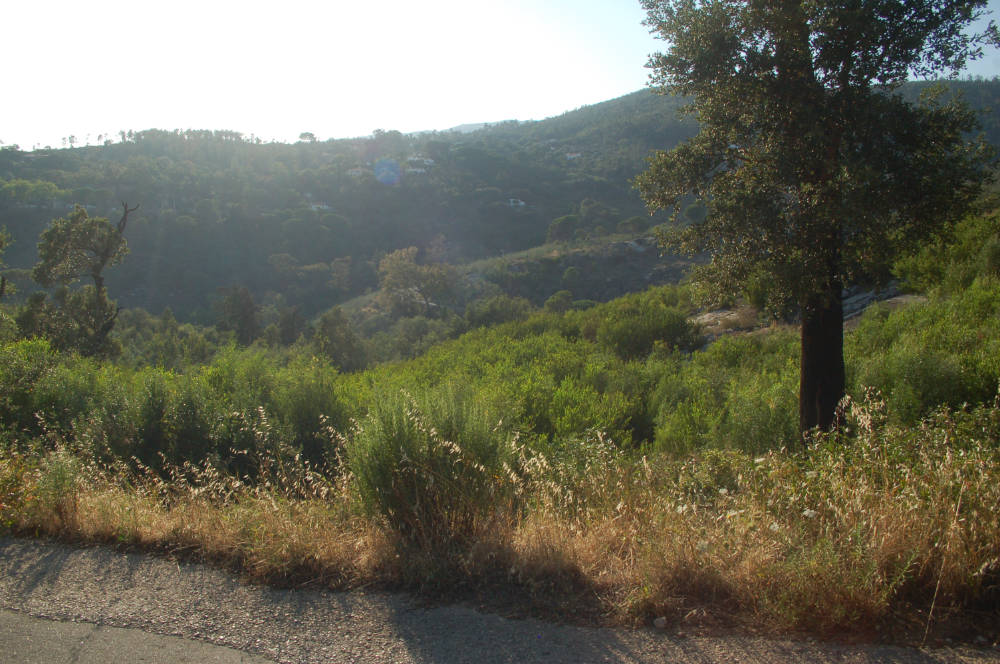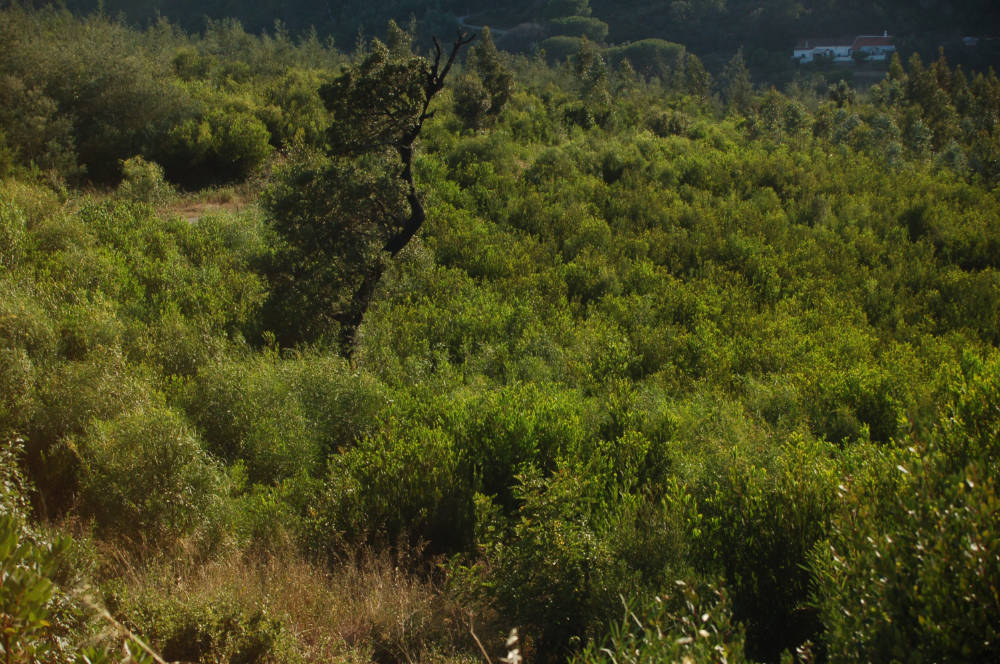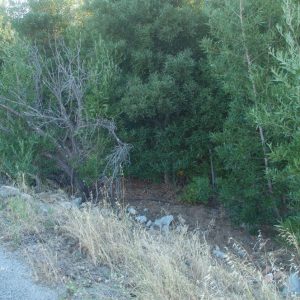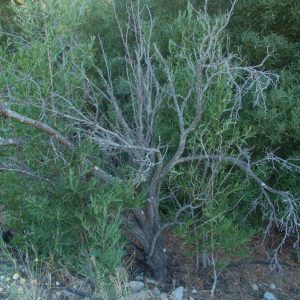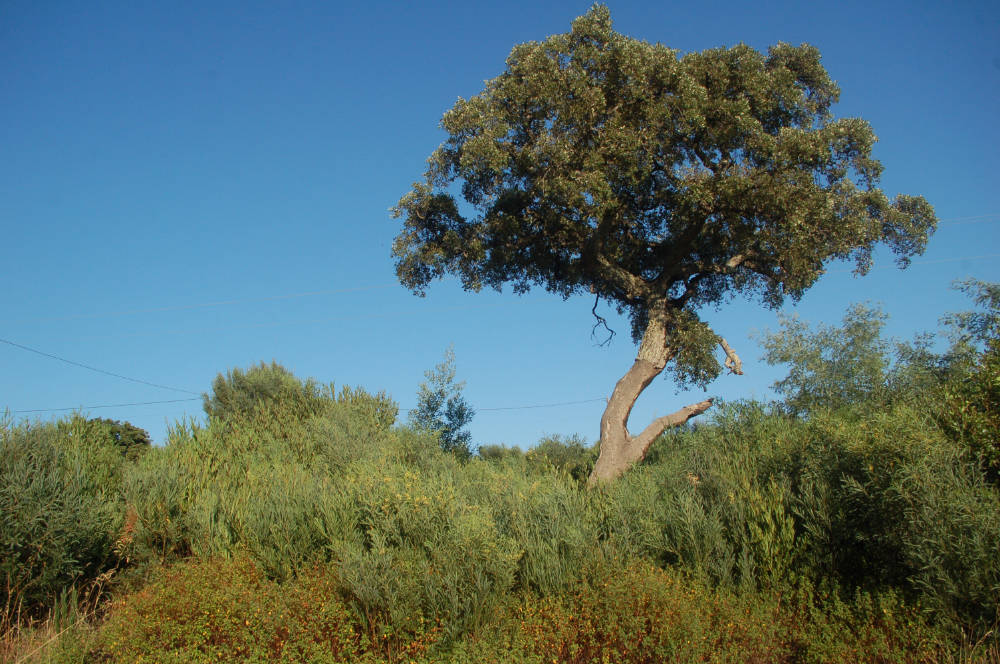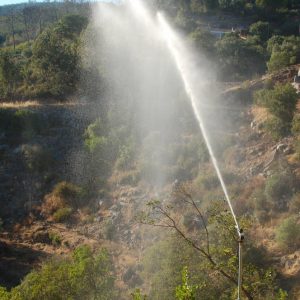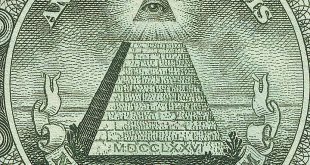Saturday the 24th of June 2023.
Those walking from Caldas de Monchique to Esgravatadouro, continuing on to Fornalha and taking the short PR5 route up to the summit of Picota cross what you could call a minefield of millions of acacia and mimosa trees. Some of them six feet high, others a little shorter still, some already taller, they reach the rim of the tarmac road. Hikers will be crossing the dead country left after the 2018 forest fires. This is where the wild shoots of acacia and mimosa grow on both sides of the tarmac, and no council whatsoever rules here, no longer. They have all capitulated and retreated faced with this minefield. Monchique town council maintains its silence when it comes to the invasive plants. The collaboration with the GEOTA nature protection association on this issue is well on the backburner. The contract signed by the previous town government has expired and not been extended. Why not, actually? This question is one that ECO123 is putting to GEOTA’s Miguel Jerónimo.
Starting in Caldas, the hiking trail leads past the ruins of the former Rouxinol restaurant up to the primary school which hasn’t been used for teaching since 1999, for lack of children. Now plastic bottle tops are being recycled here. What the owners of Caldas de Monchique had actually planned was to transform the burnt area, some 37 hectares, into a piece of real estate, to earn money with it. However, the idea turned out to be pie in the sky. When, in the winter of 2018 I urgently advise owner Vitor Hugo Goncalves to get together a group of volunteers and start pulling out the acacias and their roots by hand, while this is still possible, earns me but a smile. My written request whether I can help with consultation, is met with radio silence. Why is that?
Now, five years later, a wild jungle of acacia and mimosas has taken root and is continuing to thrive. Now no-one is pulling ht small saplings out of the ground. For acacias have roots that spread both deep and wide, that they use to claw on to the soil to steal the groundwater out of the earth. With every day going by it gets more expensive if the owner of the land wants to rid themselves of this plague. But maybe they don’t actually want this? For acacias and mimosas are persistent invasive plants. Fighting them is a fair amount of hard work. Maybe all this is but a stitch-up with nature to do with EU subventions soon ripe for the picking? For if nothing works, not even one’s own naivety, you will at some point receive EU subventions from the European Union. The EU will sort it out for sure, aren’t we in the heart of the EU Natura 2000 network, now being overgrown by invasive plants, millions of small to mid-size trees, wringing out the last drops of water from the ground and pushing out all other native trees. If you want to witness floral species extinction just visit Caldas de Monchique; we have old dying cork oaks on view, olive and carob trees, slowly being strangulated by the acacia roots. The mountain brooks around the area have already dried up. We’re talking all or nothing here. In fact, the Caldas table water with its ph value of 9.5 is already being pumped up to the ground from a depth of over 900 metres, bottled in plastic and sold as far as Macau. And 900 metres is not even the end of it. It’s not just the lack of spring rains, it’s also about a vegetation that is out of kilter, botanical human error, bringing in exotic tree species that destroy all native tree species. This is about man-made climate change and ignorance as to the native tree cover. So which counsel can we get from the ICNF on this?
Since the fire, acacias and mimosas have been a constant feature on the to-do list of ECO123’s Botanical Gardens. Having already multiplied exponentially, they were merrily carrying on. When we decided, in 2018, to transform the Esgravatadouro valley into a botanical garden, we kept a close eye on the acacia and mimosa trees. The first thing we did was to fell the burnt trees and sort out the chaos left by the forest fire. That kept us busy all winter long into the spring of 2019, alongside our journalistic work. Also, again and again we pulled young acacias out of the ground by their roots; if we hadn’t done that we’d be choked by them by now. The fact we kept an eye on those saved the native kinds of trees that we planted, for the garden is meant to one day be an open-air museum where trees with a history in these latitudes are allowed to grow, protected. Traditional tree species grow slowly, taking years, decades even, and they use the little water still available in the ground carefully, sparingly, frugally even. Many young trees we have to water every evening through the summer. For this we use water from an old capped mine and also a small stretch of the spring-fed brook that we have dammed.
When we started planting the various climate zones the valley consists of, we had left one corner completely to nature. This corner, measuring some 120 m², has two carob trees, two fig trees, two cork oaks that are still small, an old almond tree, and now 252 acacias too, grown up to a height of around seven metres. Now, five years after the forest fire, and before the arrival of the next hot summer of 2023, we are taking a closer look at this terraced corner. The terrain is steep, one incline sloping down 30 metres to the first olive trees. We also have old vines growing here, with thriving wild and impenetrable bramble bushes, making work on the acacias impossible. So first of all we have to cut the brambles to get access to the acacias. Our intention is to „really let them have it“ …
In order to minimise the risk of forest fires we set up a mobile sprinkler which moistens the entire grounds to such a degree that sparks flying from a brushcutter have no impact at all. And yes, there is also a fire extinguisher plus several buckets of water at every corner. Before we started planting, Quercus canariensis, the Monchique oak, umbrella pines, walnut trees and elms, we implemented a high-power sprinkler system. This means that during future forest fires we’ll be able to immerse the entire Botanical Gardens in water before the fire can reach them. For this, we laid down 1.¼ inch water pipes to a depth of 30 to 40 cm into the forest soil; these end in a steel tube attached to the sprinkler. This steel tube is three metres long, and in the end the sprinkler is screwed onto a thread before being concreted in and lowered down by rope. With a pressure of six bar, it has a range of 25 metres. The 5,000 litres of water it uses per hour come from a huge cistern, which in turn is filled with rain water (via roof guttering). We now have eight of these sprinklers.
Next week you can read here how ECOO123 is lowering its ecological footprint with our Botanical Garden and why native trees are the real climate champions. Every day, a forest with a thousand new native trees is transforming at least one ton of CO2 into oxygen. Do you want to be a part of this? Why not consider joining our Botanical Gardens cooperative?
 Eco123 Revista da Economia e Ecologia
Eco123 Revista da Economia e Ecologia

